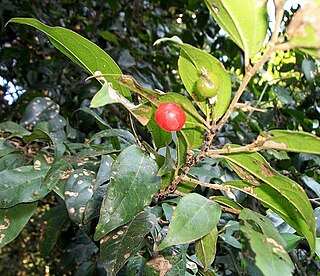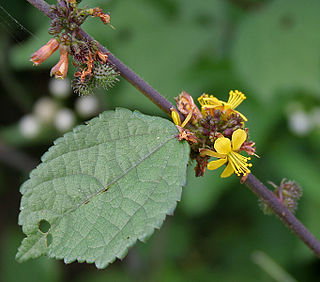
The Ginkgoaceae is a family of gymnosperms which appeared during the Mesozoic Era, of which the only extant representative is Ginkgo biloba, which is for this reason sometimes regarded as a living fossil. Formerly, however, there were several other genera, and forests of ginkgo existed. Because leaves can take such diverse forms within a single species, these are a poor measure of diversity, although differing structures of wood point to the existence of diverse ginkgo forests in ancient times.

Malpighiaceae is a family of flowering plants in the order Malpighiales. It comprises about 73 genera and 1315 species, all of which are native to the tropics and subtropics. About 80% of the genera and 90% of the species occur in the New World and the rest in the Old World.

The genus of the myrrhs, Commiphora, is the most species-rich genus of flowering plants in the frankincense and myrrh family, Burseraceae. The genus contains approximately 190 species of shrubs and trees, which are distributed throughout the (sub-) tropical regions of Africa, the western Indian Ocean islands, the Arabian Peninsula, India, and South America. The genus is drought-tolerant and common throughout the xerophytic scrub, seasonally dry tropical forests, and woodlands of these regions.

Zantedeschia rehmannii, the pink arum lily, pink calla, or red calla lily, is a herbaceous ornamental plant in the family Araceae. It is a recipient of the Royal Horticultural Society's Award of Garden Merit.

Allanblackia stuhlmannii is a species of flowering plant in the family Clusiaceae. It is found only in Tanzania.

Beilschmiedia is a genus of trees and shrubs in family Lauraceae. Most of its species grow in tropical climates, but a few of them are native to temperate regions, and they are widespread in tropical Asia, Africa, Madagascar, Australia, New Zealand, North America, Central America, the Caribbean, and South America. The best-known species to gardeners in temperate areas are B. berteroana and B. miersii because of their frost tolerance. Seeds of B. bancroftii were used as a source of food by Australian Aborigines. Timbers of some species are very valuable.
Hexalobus salicifolius is a species of flowering plant in the family Annonaceae. It is found in Cameroon, Ivory Coast, Gabon, and the Republic of the Congo. Local common names include oouè, owoé, and owui.

Olax is a plant genus in the family Olacaceae. The name derives from the Latin, olax (malodorous), and refers to the unpleasant scent of some of the Olax species. Olax is an Old World genus represented by several climbers, some species have leaves and fruits smelling of garlic such as Olax subscorpioidea and Olax gambecola, seeds of the latter are used as condiments in parts of West Africa. In India Olax nana is well known as one of the first species to emerge after forest fires, the shoots growing directly from buried roots.
Xylopia elliotii is a species of plant in the Annonaceae family. It is found in Ghana and possibly Ivory Coast.

Buchanania obovata is a small to medium-sized understorey tree in woodlands native to northern Australia, in particular in Arnhem Land in the Northern Territory. Common names include green plum and wild mango.

Celtis mildbraedii is a species of forest tree in the family Cannabaceae. It was previously assigned to the family Ulmaceae. These trees grow in limited areas of South Africa, Mozambique and Zimbabwe. They are also found in forested areas from West Africa to Sudan, DRC, Angola and Tanzania. Common names include natal white stinkwood, red-fruited white-stinkwood and natal elm. This species is more common in Tropical Africa than in Southern Africa.

Triumfetta is a genus of plants in the family Malvaceae. Burbark is a common name for plants in this genus.

Cola is a genus of trees native to the tropical forests of Africa, classified in the family Malvaceae, subfamily Sterculioideae. Species in this genus are sometimes referred to as kola tree or kola nut for the caffeine-containing fruit produced by the trees that is often used as a flavoring ingredient in beverages. The genus was thought to be closely related to the South American genus Theobroma, or cocoa, but the latter is now placed in a different subfamily. They are evergreen trees, growing up to 20 m tall, with glossy ovoid leaves up to 30 cm long and star-shaped fruit.
Dictyoneura is a genus of two-to-three species of rainforest trees known to science, constituting part of the plant family Sapindaceae.

Klainedoxa gabonensis is a large tropical African tree of the family Irvingiaceae growing to 40m in height. Its straight trunk is buttressed and up to 25m long, while its spreading evergreen crown makes it one of the largest trees of the rainforest. It is found from Senegal to Sudan, Cameroons, Ivory Coast, Democratic Republic of the Congo, Uganda and Tanzania, growing as far south as Angola and Zambia.

Melaleuca acuminata, commonly known as mallee honeymyrtle is a plant in the myrtle family, Myrtaceae and is native to Australia and widespread in temperate areas of the continent. It is an erect shrub to about 3 m (9.8 ft) usually found in mallee woodland.
Agelanthus rondensis is a species of hemiparasitic plant in the family Loranthaceae. It is endemic to Tanzania.
Agelanthus kayseri is a species of hemiparasitic plant in the family Loranthaceae, which is native to Kenya, Tanzania and Somalia.
Agelanthus keilii is a species of hemiparasitic plant in the family Loranthaceae, which is native to Rwanda, Tanzania and Burundi.
Agelanthus uhehensis is a species of hemiparasitic plant in the family Loranthaceae, which is native to Tanzania.












